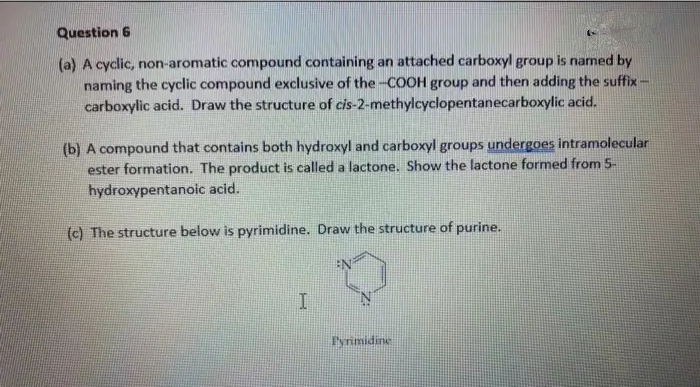(a) A cyclic, non-aromatic compound containing an attached carboxyl group is named by naming the cyclic compound exclusive of the -COOH group and then adding the suffix- carboxylic acid. Draw the structure of cis-2-methylcyclopentanecarboxylic acid. (b) A compound that contains both hydroxyl and carboxyl groups undergoes intramolecular ester formation. The product is called a lactone. Show the lactone formed from 5- hydroxypentanoic acid. (c) The structure below is pyrimidine. Draw the structure of purine.
(a) A cyclic, non-aromatic compound containing an attached carboxyl group is named by naming the cyclic compound exclusive of the -COOH group and then adding the suffix- carboxylic acid. Draw the structure of cis-2-methylcyclopentanecarboxylic acid. (b) A compound that contains both hydroxyl and carboxyl groups undergoes intramolecular ester formation. The product is called a lactone. Show the lactone formed from 5- hydroxypentanoic acid. (c) The structure below is pyrimidine. Draw the structure of purine.
Macroscale and Microscale Organic Experiments
7th Edition
ISBN:9781305577190
Author:Kenneth L. Williamson, Katherine M. Masters
Publisher:Kenneth L. Williamson, Katherine M. Masters
Chapter28: Nitration Of Methyl Benzoate
Section: Chapter Questions
Problem 1Q
Related questions
Question

Transcribed Image Text:Question 6
(a) A cyclic, non-aromatic compound containing an attached carboxyl group is named by
naming the cyclic compound exclusive of the -COOH group and then adding the suffix -
carboxylic acid. Draw the structure of cis-2-methylcyclopentanecarboxylic acid.
(b) A compound that contains both hydroxyl and carboxyl groups undergoes intramolecular
ester formation. The product is called a lactone. Show the lactone formed from 5-
hydroxypentanoic acid.
(c) The structure below is pyrimidine. Draw the structure of purine.
Iyrimidine
Expert Solution
This question has been solved!
Explore an expertly crafted, step-by-step solution for a thorough understanding of key concepts.
This is a popular solution!
Trending now
This is a popular solution!
Step by step
Solved in 3 steps with 3 images

Knowledge Booster
Learn more about
Need a deep-dive on the concept behind this application? Look no further. Learn more about this topic, chemistry and related others by exploring similar questions and additional content below.Recommended textbooks for you

Macroscale and Microscale Organic Experiments
Chemistry
ISBN:
9781305577190
Author:
Kenneth L. Williamson, Katherine M. Masters
Publisher:
Brooks Cole

World of Chemistry, 3rd edition
Chemistry
ISBN:
9781133109655
Author:
Steven S. Zumdahl, Susan L. Zumdahl, Donald J. DeCoste
Publisher:
Brooks / Cole / Cengage Learning

Macroscale and Microscale Organic Experiments
Chemistry
ISBN:
9781305577190
Author:
Kenneth L. Williamson, Katherine M. Masters
Publisher:
Brooks Cole

World of Chemistry, 3rd edition
Chemistry
ISBN:
9781133109655
Author:
Steven S. Zumdahl, Susan L. Zumdahl, Donald J. DeCoste
Publisher:
Brooks / Cole / Cengage Learning